Comparison of PRISMA Data with Model Simulations, Hyperion Reflectance and Field Spectrometer Measurements on ‘Piano delle Concazze’ (Mt. Etna, Italy)
Abstract
1. Introduction
2. Test Site Description
3. Satellite Dataset, Field Measurements and Simulated Data
3.1. PRISMA Data Description
3.2. MODTRAN Parameters for Simulations
3.3. Hyperion Data Description
3.4. FieldSpec Data Description
4. Results of Comparisons
4.1. PRISMA vs. MODTRAN Simulations: TOA Radiance Comparison
4.2. PRISMA vs. Hyperion: Reflectance Comparison
4.3. PRISMA vs. FieldSpec: Reflectance Comparison
5. Conclusions
Author Contributions
Funding
Acknowledgments
Conflicts of Interest
References
- Lorenz, S.; Zimmermann, R.; Gloaguen, R. The Need for Accurate Geometric and Radiometric Corrections of Drone-Borne Hyperspectral Data for Mineral Exploration: MEPHySTo—A Toolbox for Pre-Processing Drone-Borne Hyperspectral Data. Remote. Sens. 2017, 9, 88. [Google Scholar] [CrossRef]
- Niyogi, D.; Jamshidi, S.; Smith, D.; Kellner, O. Evapotranspiration Climatology of Indiana, USA Using In-Situ and Remotely Sensed Products. J. Appl. Meteorol. Clim. 2020, 1, 1–52. [Google Scholar] [CrossRef]
- Jamshidi, S.; Zand-Parsa, S.; Jahromi, M.N.; Niyogi, D. Application of A Simple Landsat-MODIS Fusion Model to Estimate Evapotranspiration over A Heterogeneous Sparse Vegetation Region. Remote. Sens. 2019, 11, 741. [Google Scholar] [CrossRef]
- Jamshidi, S.; Zand-Parsa, S.; Pakparvar, M.; Niyogi, D. Evaluation of Evapotranspiration over a Semiarid Region Using Multiresolution Data Sources. J. Hydrometeorol. 2019, 20, 947–964. [Google Scholar] [CrossRef]
- Chander, S.; Gujrati, A.; Krishna, A.V.; Sahay, A.; Singh, R. Remote sensing of inland water quality: A hyperspectral perspective. In Hyperspectral Remote Sensing; Elsevier: Amsterdam, The Netherlands, 2020; pp. 197–219. [Google Scholar]
- Hulley, G.C.; Duren, R.M.; Hopkins, F.M.; Hook, S.J.; Vance, N.; Guillevic, P.; Johnson, W.R.; Eng, B.T.; Mihaly, J.M.; Jovanovic, V.M.; et al. High spatial resolution imaging of methane and other trace gases with the airborne Hyperspectral Thermal Emission Spectrometer (HyTES). Atmos. Meas. Tech. 2016, 9, 2393–2408. [Google Scholar] [CrossRef]
- Bagheri, N.; Mohamadi-Monavar, H.; Azizi, A.; Ghasemi, A. Detection of Fire Blight disease in pear trees by hyperspectral data. Eur. J. Remote Sens. 2017, 51, 1–10. [Google Scholar] [CrossRef]
- National Aeronautics and Space Administration (NASA). AVIRIS Home Page. 2011. Available online: http://aviris.jpl.nasa.gov/ (accessed on 3 December 2020).
- Ramakrishnan, D.; Bharti, R. Hyperspectral remote sensing and geological applications. Curr. Sci. 2015, 108, 879–891. [Google Scholar]
- Li, L.; Solana, C.; Canters, F.; Chan, J.C.-W.; Kervyn, M. Impact of Environmental Factors on the Spectral Characteristics of Lava Surfaces: Field Spectrometry of Basaltic Lava Flows on Tenerife, Canary Islands, Spain. Remote. Sens. 2015, 7, 16986–17012. [Google Scholar] [CrossRef]
- Govender, M.; Chetty, K.; Bulcock, H.H. A review of hyperspectral remote sensing and its application in vegetation and water resource studies. Water SA 2009, 33, 145–151. [Google Scholar] [CrossRef]
- Hernández-Clemente, R.; Hornero, A.; Mottus, M.; Penuelas, J.; González-Dugo, V.; Jiménez, J.C.; Suárez, L.; Alonso, L.; Zarco-Tejada, P.J. Early Diagnosis of Vegetation Health From High-Resolution Hyperspectral and Thermal Imagery: Lessons Learned From Empirical Relationships and Radiative Transfer Modelling. Curr. For. Rep. 2019, 5, 169–183. [Google Scholar] [CrossRef]
- Jamshidi, S.; Zand-parsa; Niyogi, D. Assessing Crop Water Stress Index for Citrus Using In-Situ Measurements, Landsat, and Sentinel-2 Data. Int. J. Remote Sens. 2020, 42, 42. [Google Scholar]
- Flores-Anderson, A.I.; Griffin, R.; Dix, M.; Romero-Oliva, C.S.; Ochaeta, G.; Skinner-Alvarado, J.; Moran, M.V.R.; Hernandez, B.; Cherrington, E.; Page, B.; et al. Hyperspectral Satellite Remote Sensing of Water Quality in Lake Atitlán, Guatemala. Front. Environ. Sci. 2020, 8, 7. [Google Scholar] [CrossRef]
- Giardino, C.; Bresciani, M.; Braga, F.; Fabbretto, A.; Ghirardi, N.; Pepe, M.; Gianinetto, M.; Colombo, R.; Cogliati, S.; Ghebrehiwot, S.; et al. First Evaluation of PRISMA Level 1 Data for Water Applications. Sensors 2020, 20, 4553. [Google Scholar] [CrossRef] [PubMed]
- Sabbah, S.; Rusch, P.; Gerhard, J.-H.; Harig, R. An infrared hyperspectral sensor for remote sensing of gases in the atmosphere. In Remote Sensing; International Society for Optics and Photonics: Bellingham, WA, USA, 2010; Volume 7827, p. 78270. [Google Scholar]
- Spinetti, C.; Carrère, V.; Buongiorno, M.F.; Sutton, A.J.; Elias, T. Carbon dioxide of PuuOo volcanic plume at Kilauea retrieved by AVIRIS hyperspectral data. Remote. Sens. Environ. 2008, 112, 3192–3199. [Google Scholar] [CrossRef]
- Veraverbeke, S.; Dennison, P.; Gitas, I.Z.; Hulley, G.C.; Kalashnikova, O.V.; Katagis, T.; Kuai, L.; Meng, R.; Roberts, D.A.; Stavros, E.N. Hyperspectral remote sensing of fire: State-of-the-art and future perspectives. Remote. Sens. Environ. 2018, 216, 105–121. [Google Scholar] [CrossRef]
- Dennison, P.; Roberts, D.A. Daytime fire detection using airborne hyperspectral data. Remote. Sens. Environ. 2009, 113, 1646–1657. [Google Scholar] [CrossRef]
- Loizzo, R.; Guarini, R.; Longo, F.; Scopa, T.; Formaro, R.; Facchinetti, C.; Varacalli, G. Prisma: The Italian Hyperspectral Mission. In Proceedings of the IGARSS 2018–2018 IEEE International Geoscience and Remote Sensing Symposium, Valencia, Spain, 22–27 July 2018; Institute of Electrical and Electronics Engineers (IEEE): Piscataway, NJ, USA, 2018; pp. 175–178. [Google Scholar]
- Casa, R.; Pignatti, S.; Pascucci, S.; Ionca, V.; Mzid, N.; Veretelnikova, I. Assessment of PRISMA imaging spectrometer data for the estimation of topsoil properties of agronomic interest at the field scale. In EGU General Assembly Conference Abstracts; 22nd EGU General Assembly: Wien, Vienna, 2020; p. 6728. [Google Scholar]
- Colini, L.; Spinetti, C.; Doumaz, F.; Amici, S.; Ananasso, C.; Buongiorno, M.F.; Cafaro, P.; Caltabiano, T.; Curci, G.; D’Andrea, S.; et al. 2012 hyperspectral airborne campaign on Etna: Multi data acquisition for ASI-PRISMA project. In Proceedings of the 2013 IEEE International Geoscience and Remote Sensing Symposium–IGARSS, Melbourne, VIC, Australia, 21–26 July 2013; pp. 4427–4430. [Google Scholar]
- Buongiorno, M.F.; Amici, S.; Colini, L.; Di Stefano, G.; Doumaz, F.; Lombardo, V.; Caltabiano, T. Etna 2003 Field Campaign: Calibration and Validation of spaceborne and airborne Instruments for volcanic Applications. Quad. Geofis. 2008, 56, 1–90. [Google Scholar]
- Teillet, P.; Fedosejevs, G.; Gauthier, R.; O’Neill, N.; Thome, K.; Biggar, S.; Ripley, H.; Meygret, A. A generalized approach to the vicarious calibration of multiple Earth observation sensors using hyperspectral data. Remote. Sens. Environ. 2001, 77, 304–327. [Google Scholar] [CrossRef]
- USGS Website for the the Earth Observing-1 Mission and Hyperion Sensor Description. Available online: https://www.usgs.gov/centers/eros/science/usgs-eros-archive-earth-observing-one-eo-1-hyperion?qt-science_center_objects=0#qt-science_center_objects (accessed on 3 December 2020).
- Gvirtzman, Z.; Nur, A. The formation of Mount Etna as the consequence of slab rollback. Nat. Cell Biol. 1999, 401, 782–785. [Google Scholar] [CrossRef]
- Cocina, O.; Neri, G.; Privitera, E.; Spampinato, S. Stress tensor computations in the Mount Etna area (Southern Italy) and tectonic implications. J. Geodyn. 1997, 23, 109–127. [Google Scholar] [CrossRef]
- Hirn, A.; Nicolich, R.; Gallart, J.; Laigle, M.; Cernobori, L. ETNASEIS Scientific Group Roots of Etna volcano in faults of great earthquakes. Earth Planet. Sci. Lett. 1997, 148, 171–191. [Google Scholar] [CrossRef]
- Corradini, S.; Guerrieri, L.; Lombardo, V.; Merucci, L.; Musacchio, M.; Prestifilippo, M.; Scollo, S.; Silvestri, M.; Spata, G.; Stelitano, D. Proximal Monitoring of the 2011–2015 Etna Lava Fountains Using MSG-SEVIRI Data. Geosciences 2018, 8, 140. [Google Scholar] [CrossRef]
- Aloisi, M.; Jin, S.; Pulvirenti, F.; Scaltrito, A. The December 2015 Mount Etna eruption: An analysis of inflation/deflation phases and faulting processes. J. Geodyn. 2017, 107, 34–45. [Google Scholar] [CrossRef]
- Bonaccorso, A.; Calvari, S. A new approach to investigate an eruptive paroxysmal sequence using camera and strainmeter networks: Lessons from the 3–5 December 2015 activity at Etna volcano. Earth Planet. Sci. Lett. 2017, 475, 231–241. [Google Scholar] [CrossRef]
- Calvari, S.; Bilotta, G.; Bonaccorso, A.; Caltabiano, T.; Cappello, A.; Corradino, C.; Del Negro, C.; Ganci, G.; Neri, M.; Pecora, E.; et al. The VEI 2 Christmas 2018 Etna Eruption: A Small But Intense Eruptive Event or the Starting Phase of a Larger One? Remote Sens. 2020, 12, 905. [Google Scholar] [CrossRef]
- Corradini, S.; Guerrieri, L.; Stelitano, D.; Salerno, G.; Scollo, S.; Merucci, L.; Prestifilippo, M.; Musacchio, M.; Silvestri, M.; Lombardo, V.; et al. Near Real-Time Monitoring of the Christmas 2018 Etna Eruption Using SEVIRI and Products Validation. Remote Sens. 2020, 12, 1336. [Google Scholar] [CrossRef]
- Website for the MODTRAN Model Description. Available online: http://modtran.spectral.com/modtran_index (accessed on 3 December 2020).
- Pignatti, S.; Palombo, A.; Pascucci, S.; Romano, F.; Santini, F.; Simoniello, T.; Umberto, A.; Vincenzo, C.; Acito, N.; Diani, M.; et al. The PRISMA hyperspectral mission: Science activities and opportunities for agriculture and land monitoring. In Proceedings of the 2013 IEEE International Geoscience and Remote Sensing Symposium-IGARSS, Melbourne, VIC, Australia, 21–26 July 2013; pp. 4558–4561. [Google Scholar]
- PRISMA Website for Data Download. Available online: https://prisma.asi.it (accessed on 3 December 2020).
- Berk, A.; Anderson, G.; Acharya, P.; Bernstein, L.; Muratov, L.; Lee, J.; Fox, M.; Adler-Golden, S.; Chetwynd, J.; Hoke, M.; et al. MODTRANTM 5: 2006 update. Proc. SPIE Int. Soc. Opt Eng. 2006, 6233, 62331F. [Google Scholar]
- Berk, A.; Conforti, P.; Kennett, R.; Perkins, T.; Hawes, F.; Van Den Bosch, J. MODTRAN6: A major upgrade of the MODTRAN radiative transfer code. In Proceedings of the 2014 6th Workshop on Hyperspectral Image and Signal Processing: Evolution in Remote Sensing (WHISPERS), Lausanne, Switzerland, 24–27 June 2014. [Google Scholar]
- University of Wyoming Website for the Atmospheric Profiles Download. Available online: http://weather.uwyo.edu/upperair/sounding.html (accessed on 3 December 2020).
- Musacchio, M.; Amici, S.; Teggi, S.; Pompilio, L.; Sgavetti, M.; Buongiorno, M.F. Una nuova procedura per le Correzioni Atmosferiche: Applicazione sulla Solfatara di Pozzuoli. Riv. Ital. Telerilevamento 2007, 39, 77–86. [Google Scholar]
- Yao, B.; Liu, C.; Teng, S.; Bi, L.; Zhang, Z.; Zhang, P.; Sohn, B.-J. An accurate and efficient radiative transfer model for simulating all-sky images from Fengyun satellite radiometers. Sci. China Earth Sci. 2020, 63, 1701–1713. [Google Scholar] [CrossRef]
- Ham, S.-H.; Sohn, B.; Yang, P.; Baum, B.A. Assessment of the Quality of MODIS Cloud Products from Radiance Simulations. J. Appl. Meteorol. Clim. 2009, 48, 1591–1612. [Google Scholar] [CrossRef][Green Version]
- Spinetti, C.; Mazzarini, F.; Casacchia, R.; Colini, L.; Neri, M.; Behncke, B.; Salvatori, R.; Buongiorno, M.F.; Pareschi, M.T. Spectral properties of volcanic materials from hyperspectral field and satellite data compared with LiDAR data at Mt. Etna. Int. J. Appl. Earth Obs. Geoinf. 2009, 11, 142–155. [Google Scholar] [CrossRef]
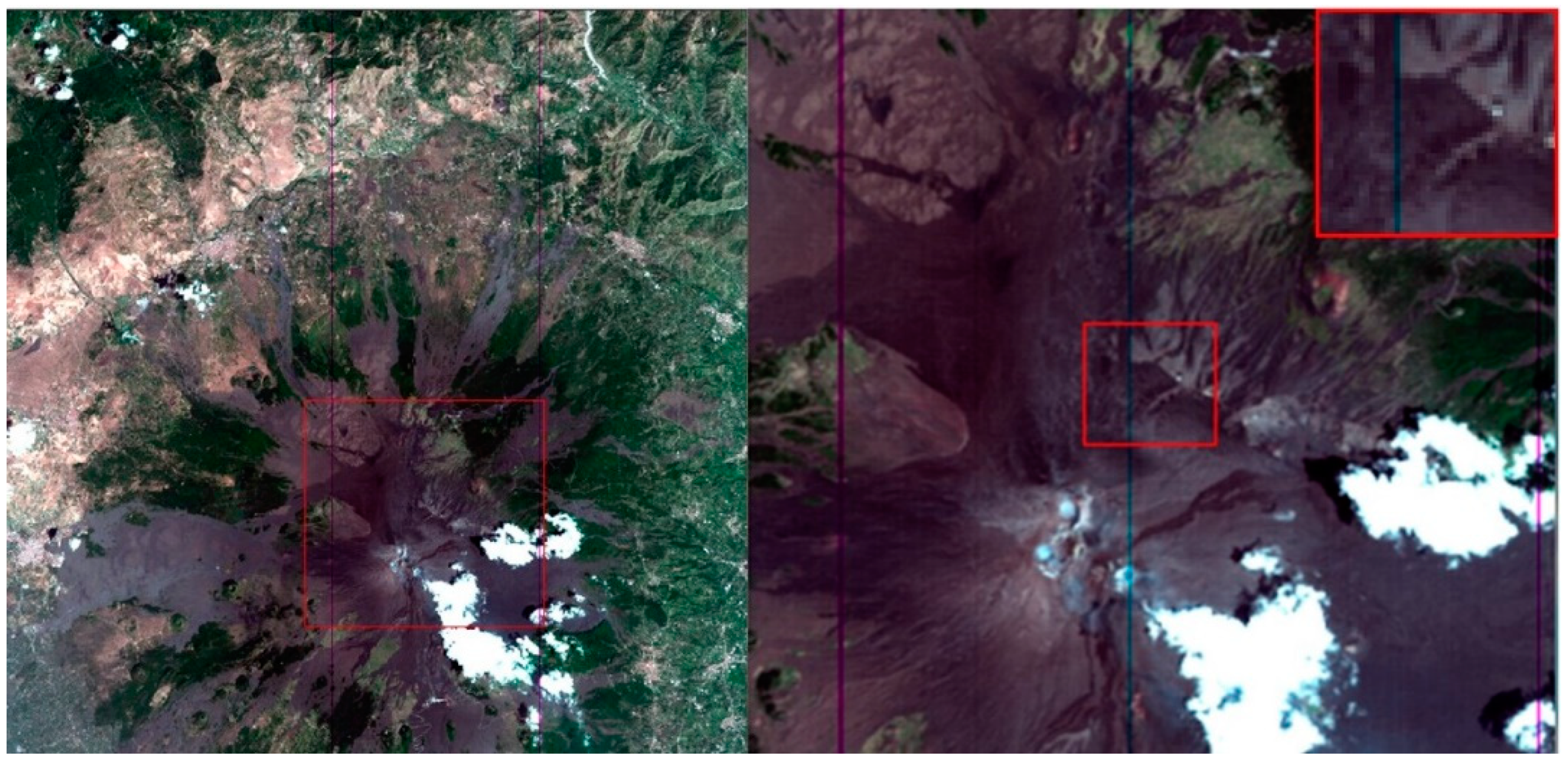
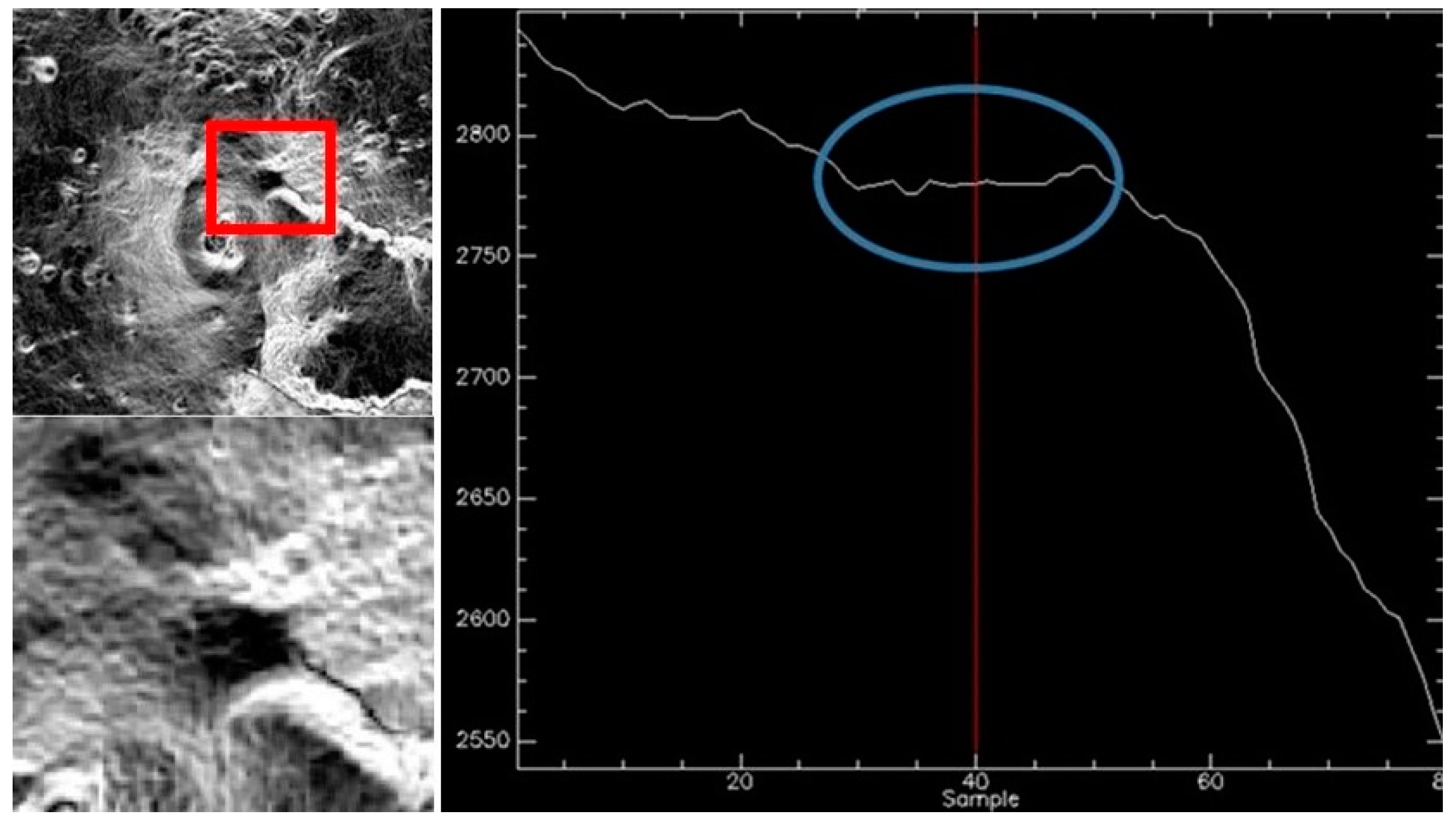

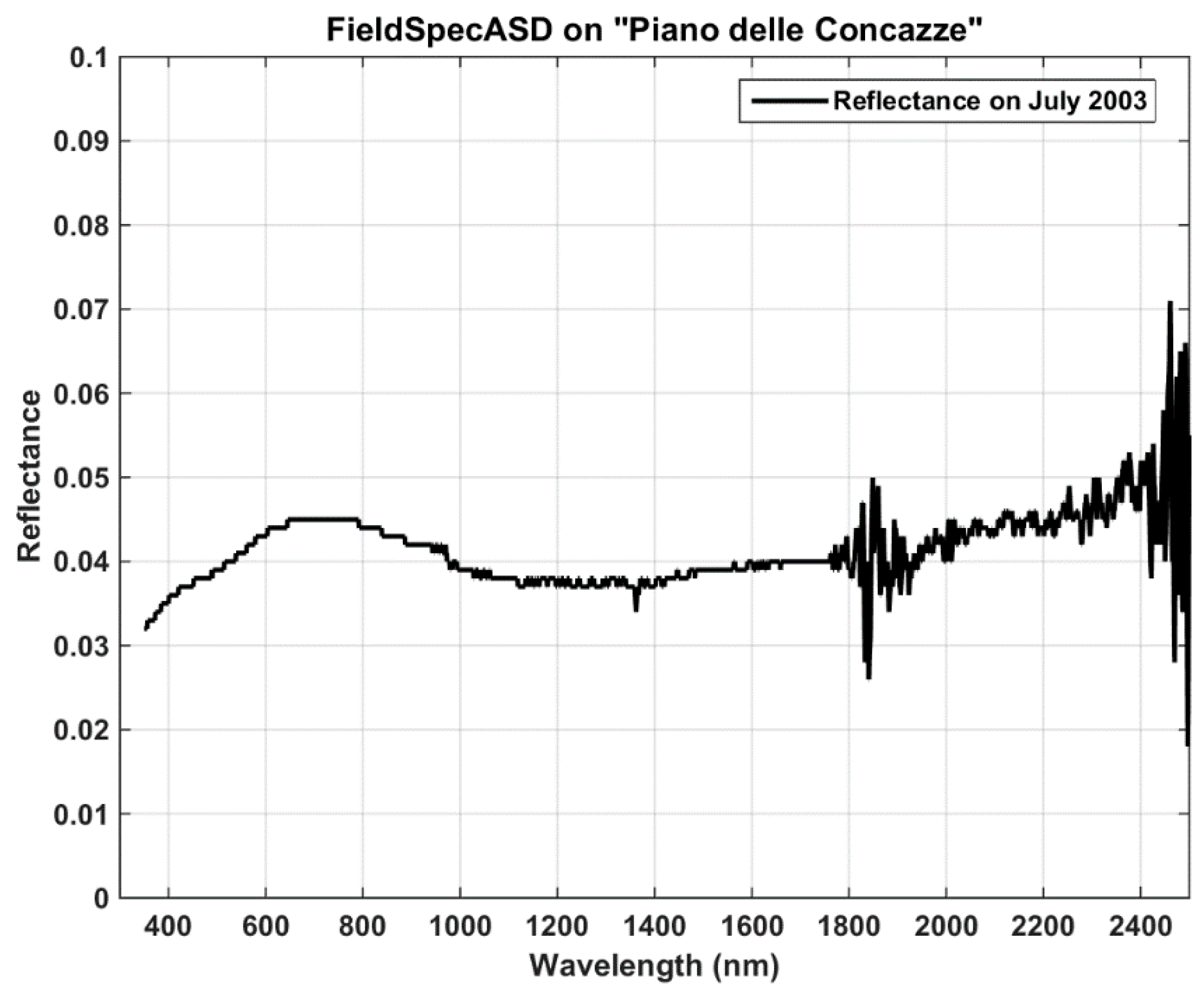
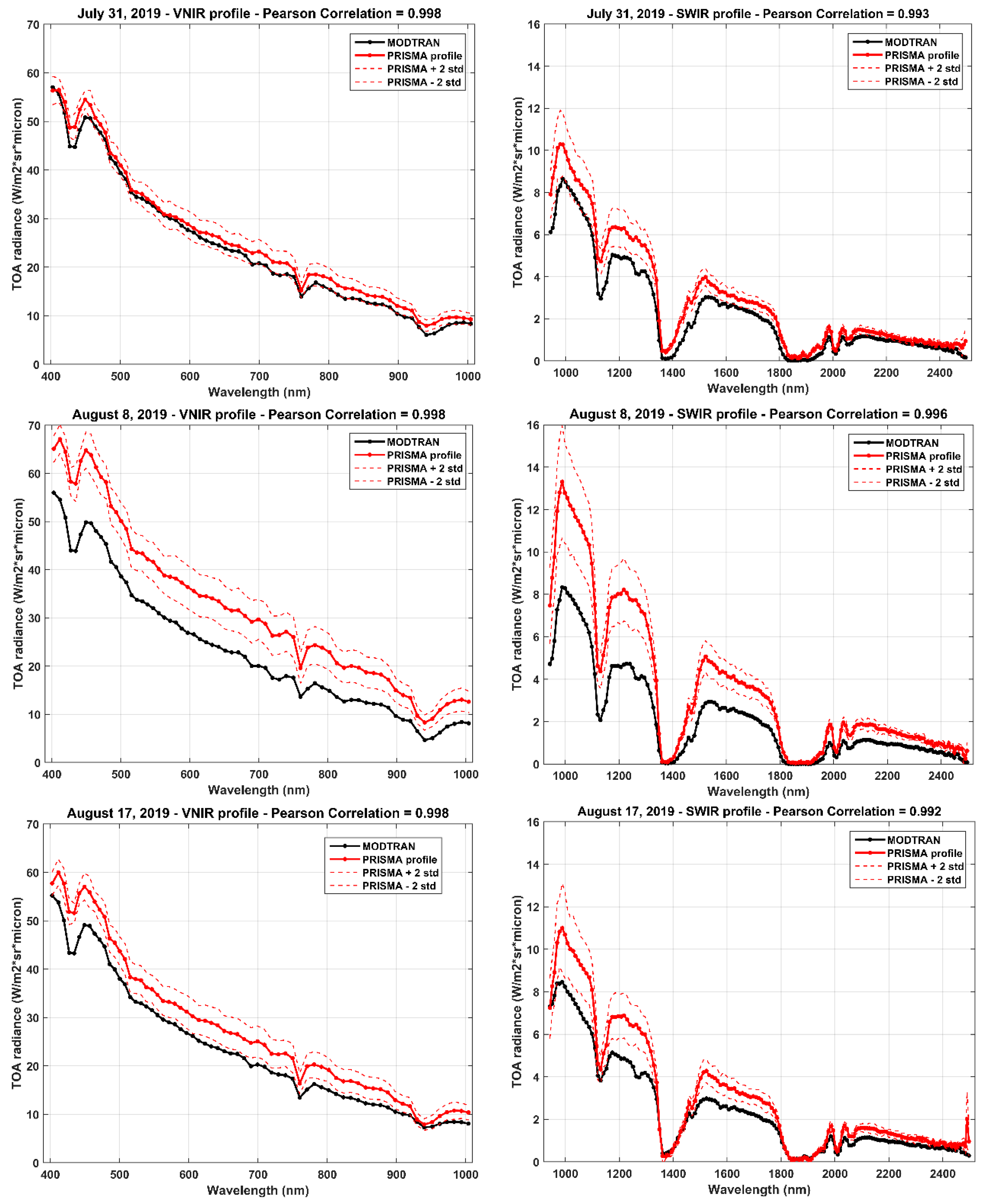
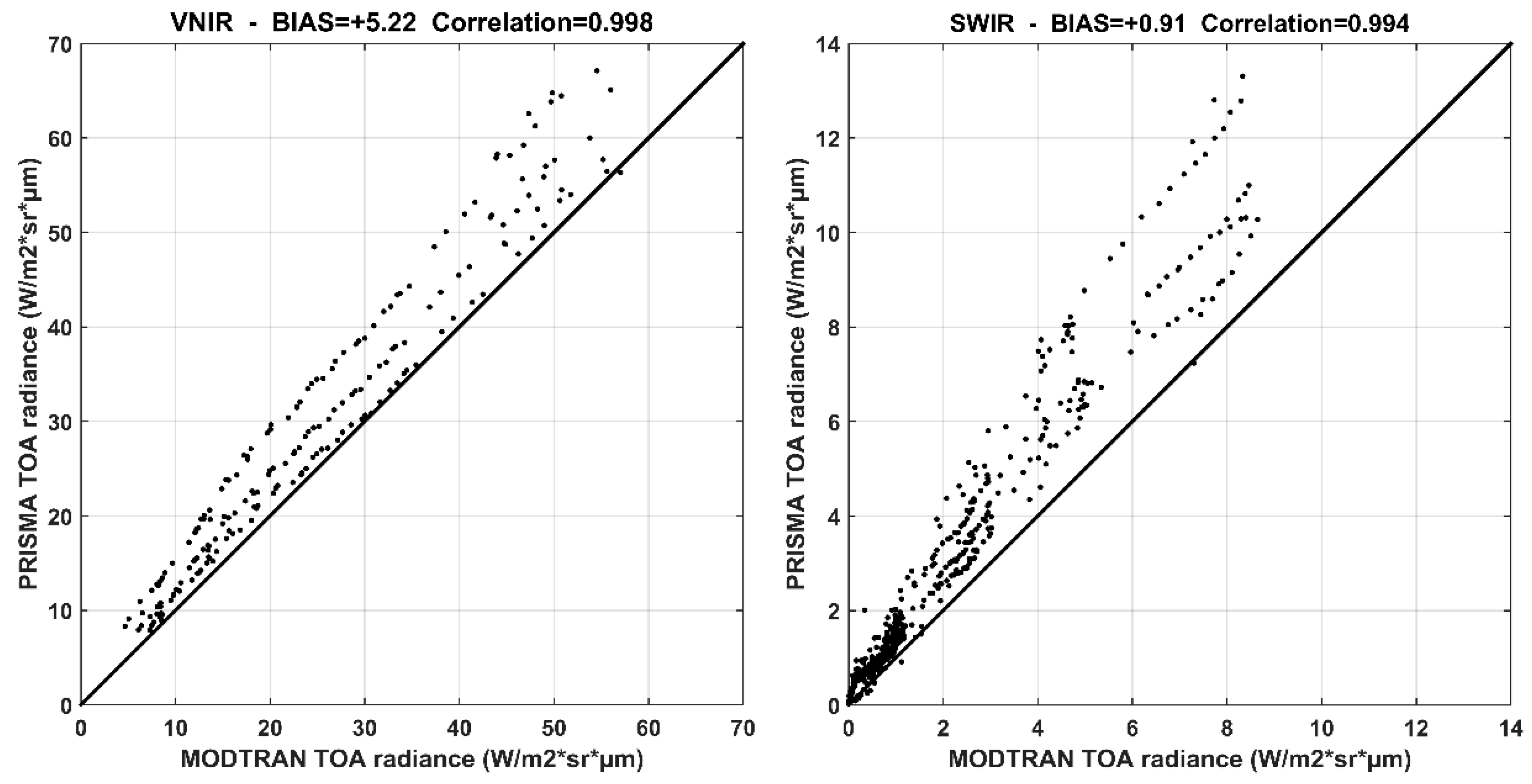
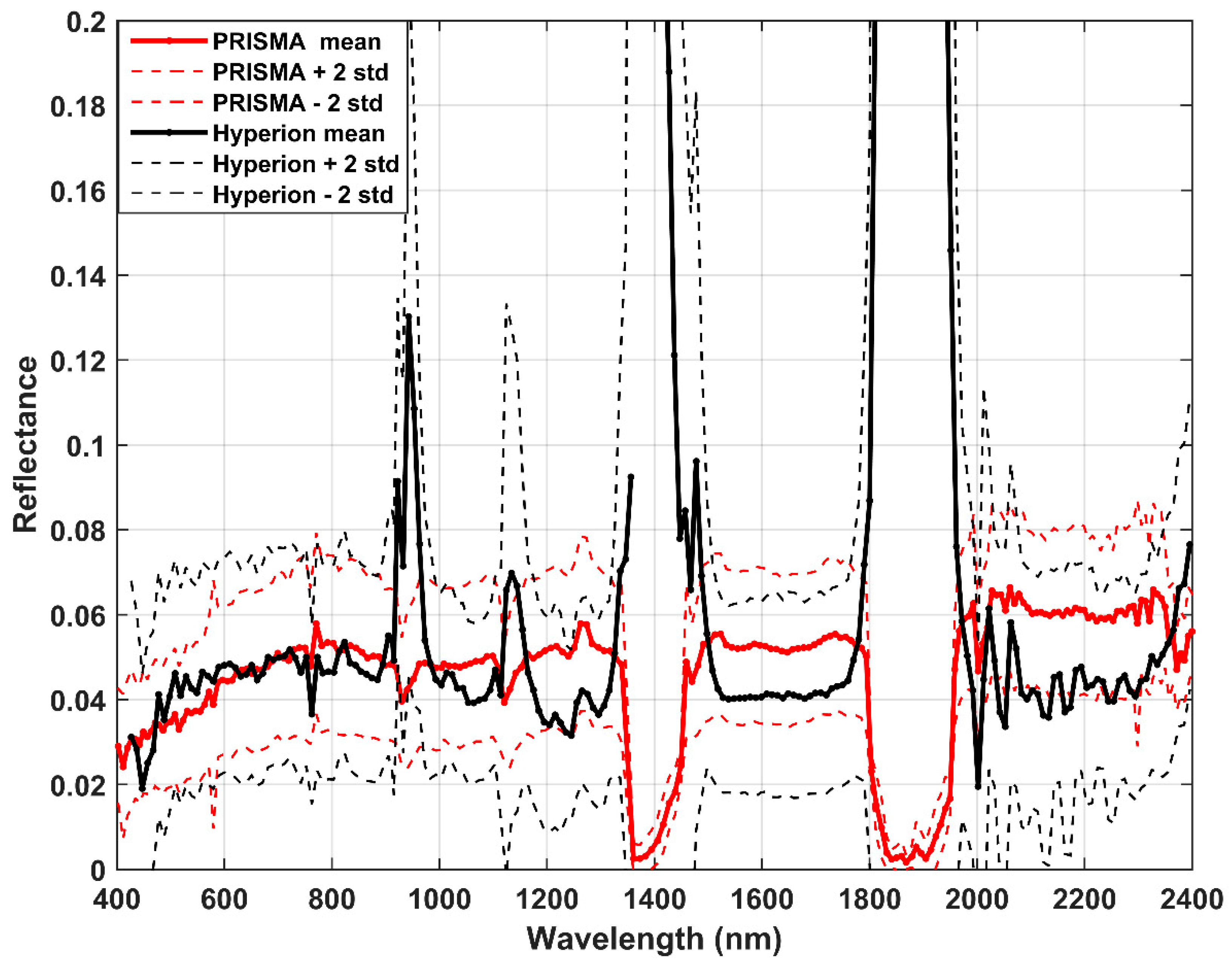
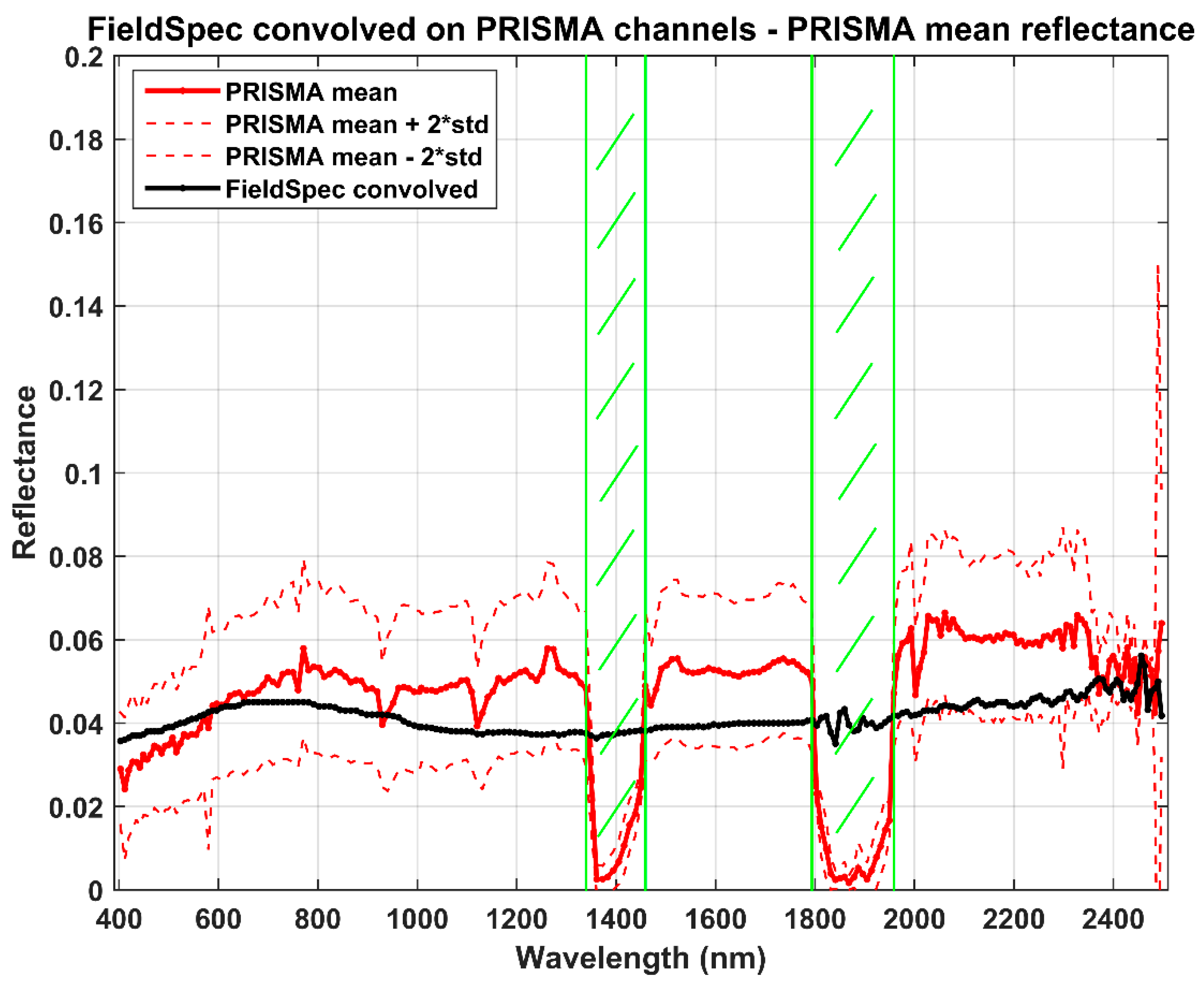
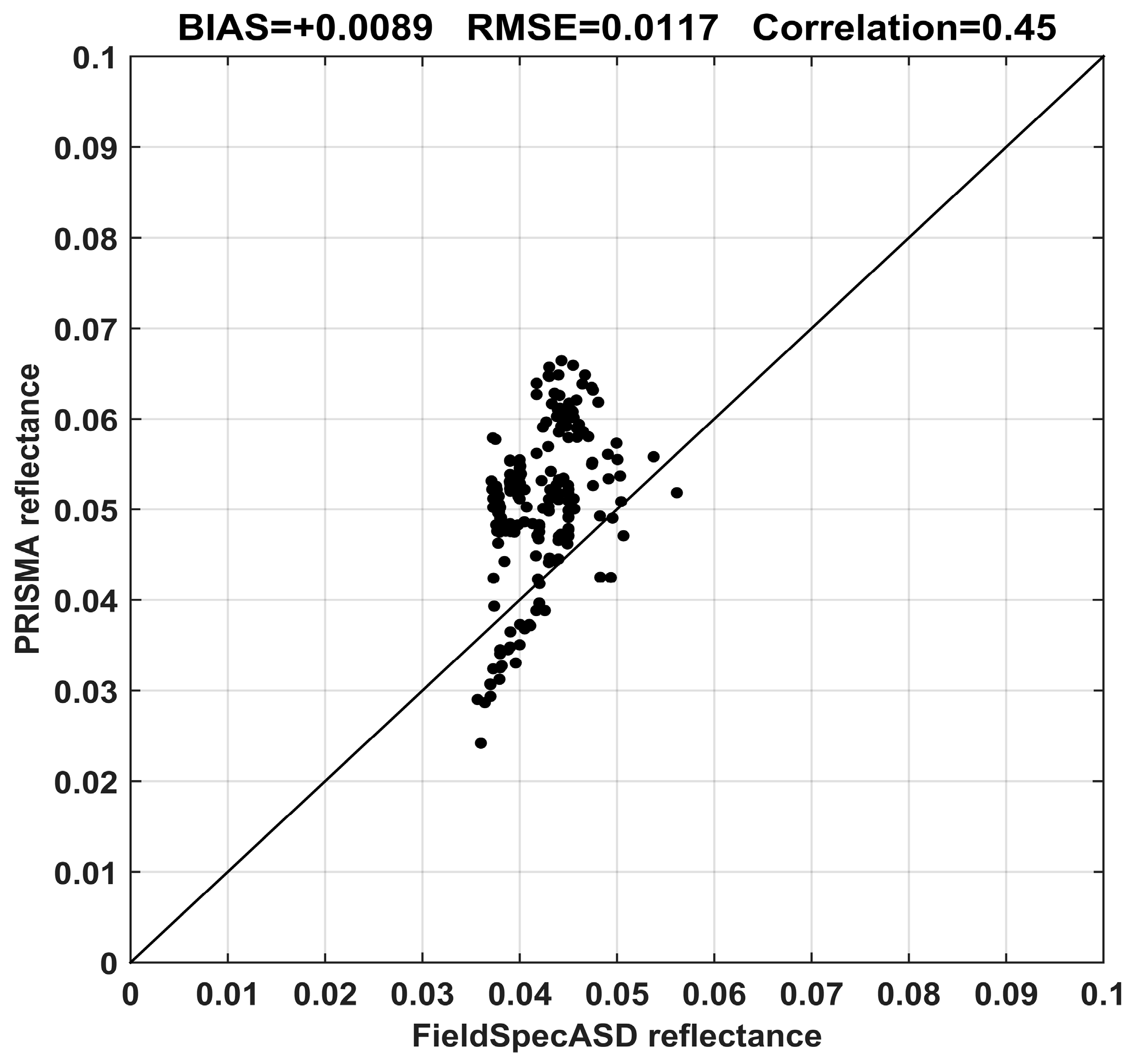
| PRISMA | MODTRAN (Simulations) | Hyperion | FieldSpec ASD | |
|---|---|---|---|---|
| Radiance (TOA) | 31 July 2019 8 August 2019 17 August 2019 | Point simulations synchronous with PRISMA | n/a | n/a |
| Reflectance | 31 July 2019 8 August 2019 17 August 2019 | n/a | Acquisitions from 2001 to 2009 | Field campaign in July 2003 |
| MODTRAN Parameter | Value |
|---|---|
| Surface albedo | Reflectance at ground acquired with the FieldSpec ASD spectrometer at PdC |
| Surface temperature | 283 K |
| Geographical-seasonal model atmosphere | Radiosonde profiles acquired from Trapani (Sicily) station on 31 July, 8 and 17 August 2019; Mid-latitude summer (above 25 km) |
| Altitude of surface (a.s.l.) | 2700 m (PdC mean altitude) |
| Initial zenith angle as measured from PdC | 178 deg |
| Spectral range | 0.4–2.5 µm (4000–25,000 cm−1) |
| Sun zenith angle | 24° |
| Date | Model Simulations VNIR | PRISMA VNIR | Model Simulations SWIR | PRISMA VNIR |
|---|---|---|---|---|
| 31 July 2019 | 25.53 | 27.14 | 2.11 | 2.75 |
| 8 August 2019 | 24.84 | 33.64 | 1.94 | 3.31 |
| 17 August 2019 | 24.83 | 29.08 | 2.19 | 2.91 |
| Spectral Range (nm) | Hyperion | PRISMA | Absolute Difference PRISMA-Hyperion |
|---|---|---|---|
| Sector 1: 427.1–908.9 | 0.0448 | 0.0438 | −0.0010 |
| Sector 2: 972.9–1109.8 | 0.0438 | 0.0484 | 0.0046 |
| Sector 3: 1163.5–1328.1 | 0.0387 | 0.0522 | 0.0135 |
| Sector 4: 1501.8–1774.9 | 0.0427 | 0.0531 | 0.0104 |
| Sector 5: 1975.8–2364.4 | 0.0445 | 0.0606 | 0.0161 |
Publisher’s Note: MDPI stays neutral with regard to jurisdictional claims in published maps and institutional affiliations. |
© 2020 by the authors. Licensee MDPI, Basel, Switzerland. This article is an open access article distributed under the terms and conditions of the Creative Commons Attribution (CC BY) license (http://creativecommons.org/licenses/by/4.0/).
Share and Cite
Romaniello, V.; Silvestri, M.; Buongiorno, M.F.; Musacchio, M. Comparison of PRISMA Data with Model Simulations, Hyperion Reflectance and Field Spectrometer Measurements on ‘Piano delle Concazze’ (Mt. Etna, Italy). Sensors 2020, 20, 7224. https://doi.org/10.3390/s20247224
Romaniello V, Silvestri M, Buongiorno MF, Musacchio M. Comparison of PRISMA Data with Model Simulations, Hyperion Reflectance and Field Spectrometer Measurements on ‘Piano delle Concazze’ (Mt. Etna, Italy). Sensors. 2020; 20(24):7224. https://doi.org/10.3390/s20247224
Chicago/Turabian StyleRomaniello, Vito, Malvina Silvestri, Maria Fabrizia Buongiorno, and Massimo Musacchio. 2020. "Comparison of PRISMA Data with Model Simulations, Hyperion Reflectance and Field Spectrometer Measurements on ‘Piano delle Concazze’ (Mt. Etna, Italy)" Sensors 20, no. 24: 7224. https://doi.org/10.3390/s20247224
APA StyleRomaniello, V., Silvestri, M., Buongiorno, M. F., & Musacchio, M. (2020). Comparison of PRISMA Data with Model Simulations, Hyperion Reflectance and Field Spectrometer Measurements on ‘Piano delle Concazze’ (Mt. Etna, Italy). Sensors, 20(24), 7224. https://doi.org/10.3390/s20247224





